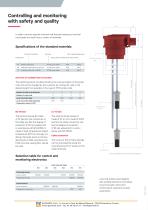 Website:
Galvatek
Website:
Galvatek
Catalog excerpts

Detecting liquid levels with conductive Level Rod-Probes Liquid levels in process and storage tanks need to be measured and monitored, since unwanted variations in these levels (due to evaporation or removal of the process liquids) must be corrected. In this respect, there are two different general tasks: permit automatic execution of process operations (such as dosing of liquids) to prevent possible damage (dry-running, heating without sufcient liquid) to the devices (pumps, heaters) installed in the tanks or to prevent an overow of the process liquid from the tanks. You can assure the safe control and monitoring of the liquid level in your tank by using level rod-probes. Since these are purely passive devices, suitable electronic controllers are needed. Level rod-probes operate on the conductive principle, which means that they can be used only in electrically conductive liquids (conductivity >10 μS). Encrustation and contamination in the tank normally have no effect on the function of the probes. Possible deposits of encrustation between the tips of the probe can be avoided by ensuring that the difference between the probe-rod lengths is at least 60 mm. The levels of non-conductive or poorly conducting liquids, in which level rod-probes cannot be used, can be controlled and monitored by our oat switches. The level rod-probes are available in many different versions: tion of one to four different levels and temperature sensor. A suitable electronic controller applies a low alternating voltage to the probe rods. A current then ows from the electrically conductive tips of the rods and through the conductive liquid to the reference electrode, called the ground rod. The electrical circuit is closed. If the liquid level drops below the tip of a probe rod, the related electrical circuit is opened. The electronic controller detects the two states “current” and “no current”. The ground rod must be at least as long as the longest rod. If the distance between the tips of the minimum and maximum probe rods is more than 1000 mm, an additional ground rod must be provided. Level rod-probes NS with terminal casing LC In metallic, electrically conductive tanks, no ground rod is needed if the ground terminal is connected directly to the tank. In order to prevent the rods from touching each other, PTFE spacers r, are tted on probes with rod lengths of 300 mm or more. The level rod-probes are available with the small terminal casing LC (material PP) or LC / L (material PVDF) and the large terminal casing BC (material PP) or BC / L (material PVDF). Level rod-probes with terminal casing BC can be mounted onto the edge of the tank by the supports HB (PP) or HB / L (PVDF) or on a crossbeam by means of the mounting sleeve EM or the holding sleeve HM. Level rod-probes with terminal casing LC are mounted onto the edge of the tank by the supports HL (PP) or HL / L (PVDF), or on crossbeams by means of the holding sleeve ML. GALVATEK S.A.S - 9, rue de la Tour du Mesnil-Renard - 78270 Bonnières, France www.galvatek.com - Tél. 01 30 93 07 57 Fax. 01 30 93 25 04 - info@galvatek.fr
Open the catalog to page 1
In order to ensure optimal chemical and thermal resistance, the level rod-probes are made from a variety of materials. Specications of the standard materials Probe rod material Code letter Max. liquid temperature Temp. Sensor material (in case of NT) PTFE-Compound Stainless steel (Mat.No. 316TI) Stainless steel (Mat.No. 316TI) PTFE, pure-white Polyolen (PO) PTFE, pure-white PTFE, pure-white Overview of Available Level Rod-Probes vail The switching points are determined by the various lengths of the probe rods and can be changed by the customer by cutting the rods to the desired length (not...
Open the catalog to page 2All Galvatek catalogs and technical brochures
-
Float Switches - MTS
2 Pages
-
General Product brochure
8 Pages
-
Rotkappe BC
2 Pages
-
Temperature limiter - ETB200
1 Pages
-
MINIBOX - 2M02
1 Pages
-
BC and BC/L
2 Pages
-
ROTKAPPE ABS
2 Pages
-
PTFE Rod Heaters GALMAFORM
2 Pages
-
BASE HEATER - 560401
1 Pages
-
Temperature control probes
1 Pages
-
control box
2 Pages
-
Control-Therm Type T
1 Pages
-
Control-Therm Type U
1 Pages
-
CALOR heating cartridges
2 Pages
-
Rotkappe LC
2 Pages













































